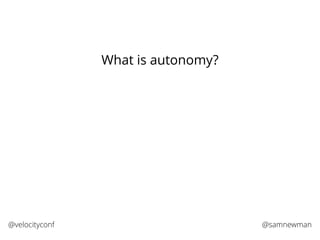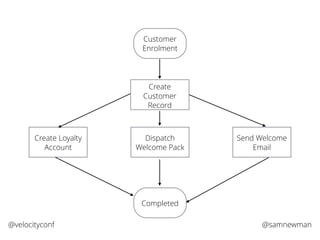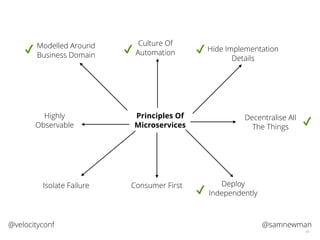Ad
Principles of microservices velocity
- 1. PRINCIPLES OF MICROSERVICES Sam Newman Velocity Santa Clara, May 2015 1
- 5. @samnewman@velocityconf Accounts Returns Invoicing Shipping Inventory Customer Service Small Autonomous services that work together
- 6. @samnewman@velocityconf 5 Show Gilt, Groupon, Netflix, Amazon
- 7. @samnewman@velocityconf 5 Show Gilt, Groupon, Netflix, Amazon
- 8. @samnewman@velocityconf 5 Show Gilt, Groupon, Netflix, Amazon
- 11. @samnewman@velocityconf Strategic Goals Architectural Principles Design and Delivery Practices Enable scalable business More customers/transactions Self-service for customers Support entry into new markets Flexible operational processes New products and operational processes Support innovation in existing markets Flexible operational processes New products and operational processes Reduce inertia Make choices that favour rapid feedback and change, with reduced dependencies across teams. Eliminate accidental complexity Aggressively retire and replace unnecessarily complex processes, systems, and integrations so that we can focus on the essential complexity. Consistent interfaces and data flows Eliminate duplication of data and create clear systems of record, with consistent integration interfaces. No silver bullets Off the shelf solutions deliver early value but create inertia and accidental complexity. Standard REST/HTTP Encapsulate legacy Eliminate integration databases Consolidate and cleanse data Published integration model Small independent Services Continuous deployment Minimal customisation of COTS/SAAS
- 12. @samnewman@velocityconf Small Autonomous services that work together
- 15. @samnewman@velocityconf 10 Principles Of Microservices Modelled Around Business Domain Culture Of Automation
- 16. @samnewman@velocityconf 10 Principles Of Microservices Modelled Around Business Domain Culture Of Automation Hide Implementation Details
- 17. @samnewman@velocityconf 10 Principles Of Microservices Modelled Around Business Domain Culture Of Automation Hide Implementation Details Decentralise All The Things
- 18. @samnewman@velocityconf 10 Principles Of Microservices Modelled Around Business Domain Culture Of Automation Hide Implementation Details Decentralise All The Things Deploy Independently
- 19. @samnewman@velocityconf 10 Principles Of Microservices Modelled Around Business Domain Culture Of Automation Hide Implementation Details Decentralise All The Things Deploy Independently Consumer First
- 20. @samnewman@velocityconf 10 Principles Of Microservices Modelled Around Business Domain Culture Of Automation Hide Implementation Details Decentralise All The Things Isolate Failure Deploy Independently Consumer First
- 21. @samnewman@velocityconf 10 Principles Of Microservices Modelled Around Business Domain Culture Of Automation Hide Implementation Details Decentralise All The Things Isolate Failure Deploy Independently Highly Observable Consumer First
- 22. @samnewman@velocityconf 10 Principles Of Microservices Modelled Around Business Domain Culture Of Automation Hide Implementation Details Decentralise All The Things Isolate Failure Deploy Independently Highly Observable Consumer First
- 32. 14
- 33. 14 Register a new customer
- 34. 14 Register a new customer Oil Change
- 35. 14 Register a new customer Emission Test Oil Change
- 36. 14 Register a new customer Emission Test Replace Tire Oil Change
- 37. 14 Register a new customer Order parts Emission Test Replace Tire Oil Change
- 38. 14 Register a new customer Order parts Emission Test Replace Tire Oil Change Send an invoice
- 39. 14 Register a new customer Order parts Emission Test Replace Tire Oil Change Send an invoice Make a repair
- 40. 14 Register a new customer Order parts Emission Test Replace Tire Oil Change Send an invoice Make a repair Contact a customer
- 41. 14 Register a new customer Order parts Emission TestReplace Tire Oil Change Send an invoice Make a repair Contact a customer
- 44. @samnewman@velocityconf 17 Principles Of Microservices Modelled Around Business Domain Culture Of Automation Hide Implementation Details Decentralise All The Things Isolate Failure Deploy Independently Highly Observable ✔ Consumer First
- 45. @samnewman@velocityconf 17 Principles Of Microservices Modelled Around Business Domain Culture Of Automation Hide Implementation Details Decentralise All The Things Isolate Failure Deploy Independently Highly Observable ✔ Consumer First
- 48. @samnewman@velocityconf 3 Months 2 Microservices 12 Months 10 Microservices
- 49. @samnewman@velocityconf 3 Months 2 Microservices 12 Months 10 Microservices 18 Months 60 Microservices
- 53. @samnewman@velocityconf 20 Principles Of Microservices Modelled Around Business Domain Culture Of Automation Hide Implementation Details Decentralise All The Things Isolate Failure Deploy Independently Highly Observable ✔ ✔ Consumer First
- 54. @samnewman@velocityconf 20 Principles Of Microservices Modelled Around Business Domain Culture Of Automation Hide Implementation Details Decentralise All The Things Isolate Failure Deploy Independently Highly Observable ✔ ✔ Consumer First
- 67. @samnewman@velocityconf Client Library BE CAREFUL OF CLIENT LIBRARIES Client Library Client Library
- 68. @samnewman@velocityconf 24 Principles Of Microservices Modelled Around Business Domain Culture Of Automation Hide Implementation Details Decentralise All The Things Isolate Failure Deploy Independently Highly Observable ✔ ✔ ✔ Consumer First
- 69. @samnewman@velocityconf 24 Principles Of Microservices Modelled Around Business Domain Culture Of Automation Hide Implementation Details Decentralise All The Things Isolate Failure Deploy Independently Highly Observable ✔ ✔ ✔ Consumer First
- 72. @samnewman@velocityconf What is autonomy? Giving people as much freedom as possible to do the job at hand
- 73. @samnewman@velocityconf What is autonomy? Giving people as much freedom as possible to do the job at hand
- 79. @samnewman@velocityconf DUMB-PIPES, SMART ENDPOINTS Magical Mystery Bus
- 86. @samnewman@velocityconf Create Customer Record Customer Enrolment Dispatch Welcome Pack Create Loyalty Account Send Welcome Email
- 87. @samnewman@velocityconf Create Customer Record Customer Enrolment Dispatch Welcome Pack Create Loyalty Account Send Welcome Email Completed
- 91. @samnewman@velocityconf Customer Service create Loyalty Bank create Email send email ORCHESTRATION
- 97. @samnewman@velocityconf CHOREOGRAPHED Customer Service create customer created Loyalty Bank Email
- 102. @samnewman@velocityconf 38 Principles Of Microservices Modelled Around Business Domain Culture Of Automation Hide Implementation Details Isolate Failure Deploy Independently Highly Observable ✔ ✔ ✔ Decentralise All The Things ✔ Consumer First
- 103. @samnewman@velocityconf 38 Principles Of Microservices Modelled Around Business Domain Culture Of Automation Hide Implementation Details Isolate Failure Deploy Independently Highly Observable ✔ ✔ ✔ Decentralise All The Things ✔ Consumer First
- 105. @samnewman@velocityconf ONE SERVICE PER-HOST Host Service Host Service Service Service Service VS
- 116. @samnewman@velocityconf 43 Principles Of Microservices Modelled Around Business Domain Culture Of Automation Hide Implementation Details Isolate Failure Highly Observable ✔ ✔ ✔ Decentralise All The Things ✔ Deploy Independently✔ Consumer First
- 117. @samnewman@velocityconf 43 Principles Of Microservices Modelled Around Business Domain Culture Of Automation Hide Implementation Details Isolate Failure Highly Observable ✔ ✔ ✔ Decentralise All The Things ✔ Deploy Independently✔Consumer First
- 125. @samnewman@velocityconf 49 Principles Of Microservices Modelled Around Business Domain Culture Of Automation Hide Implementation Details Isolate Failure Highly Observable ✔ ✔ ✔ Decentralise All The Things ✔ Deploy Independently✔ Consumer First✔
- 126. @samnewman@velocityconf 49 Principles Of Microservices Modelled Around Business Domain Culture Of Automation Hide Implementation Details Isolate Failure Highly Observable ✔ ✔ ✔ Decentralise All The Things ✔ Deploy Independently✔ Consumer First✔
- 132. @samnewman@velocityconf AVOID THE DISTRIBUTED SINGLE POINT OF FAILURE!
- 134. @samnewman@velocityconf Strangler App Legacy App Legacy AppLegacy App
- 135. @samnewman@velocityconf Strangler App Legacy App Legacy App Requests Legacy App
- 136. @samnewman@velocityconf Strangler App Legacy App Legacy App Requests Legacy App
- 137. @samnewman@velocityconf Strangler App Legacy App Legacy App Requests Legacy App
- 138. @samnewman@velocityconf Strangler App Legacy App Legacy App Requests Legacy App 30 - 60 Concurrent Requests
- 139. @samnewman@velocityconf Strangler App Legacy App Legacy App Requests Legacy App 30 - 60 Concurrent Requests > 800 Concurrent Requests
- 140. @samnewman@velocityconf Strangler App Legacy App Legacy App Requests Legacy App 30 - 60 Concurrent Requests > 800 Concurrent Requests
- 141. @samnewman@velocityconf Strangler App Legacy App Legacy App Legacy App Thread Pool
- 142. @samnewman@velocityconf Strangler App Legacy App Legacy App Legacy App Thread Pool Failing…slowly!
- 143. @samnewman@velocityconf Strangler App Legacy App Legacy App Legacy App Thread Pool Failing…slowly!
- 144. @samnewman@velocityconf Strangler App Legacy App Legacy App Legacy App Thread Pool Failing…slowly! Thread-pool exhausted
- 145. @samnewman@velocityconf Strangler App Legacy App Legacy App Legacy App Thread Pool Failing…slowly! Thread-pool exhausted No requests to other downstream apps
- 146. @samnewman@velocityconf Strangler App Legacy App Legacy App Legacy App Thread Pool Failing…slowly! Thread-pool exhausted No requests to other downstream apps
- 147. @samnewman@velocityconf Strangler App Legacy App Legacy App Legacy App Thread Pool Failing…slowly! Thread-pool exhausted Requests Building Up No requests to other downstream apps
- 148. @samnewman@velocityconf Strangler App Legacy App Legacy App Legacy App Thread Pool
- 149. @samnewman@velocityconf Strangler App Legacy App Legacy App Legacy App Fix Timeouts Thread Pool
- 150. @samnewman@velocityconf Strangler App Legacy App Legacy App Legacy App Fix Timeouts Thread Pool
- 151. @samnewman@velocityconf Strangler App Legacy App Legacy App Legacy App Fix Timeouts Thread Pool Thread PoolThread Pool
- 152. @samnewman@velocityconf Strangler App Legacy App Legacy App Legacy App Fix Timeouts Thread Pool Thread PoolThread Pool Bulkhead Downstream Connections
- 153. @samnewman@velocityconf Strangler App Legacy App Legacy App Legacy App Fix Timeouts Thread Pool Thread PoolThread Pool Bulkhead Downstream Connections
- 154. @samnewman@velocityconf Strangler App Legacy App Legacy App Legacy App Fix Timeouts Thread Pool Thread PoolThread Pool Bulkhead Downstream Connections Circuit Breakers
- 155. @samnewman@velocityconf 55 Principles Of Microservices Modelled Around Business Domain Culture Of Automation Hide Implementation Details Highly Observable ✔ ✔ ✔ Decentralise All The Things ✔ Deploy Independently✔ Isolate Failure✔ Consumer First✔
- 156. @samnewman@velocityconf 55 Principles Of Microservices Modelled Around Business Domain Culture Of Automation Hide Implementation Details Highly Observable ✔ ✔ ✔ Decentralise All The Things ✔ Deploy Independently✔ Isolate Failure✔ Consumer First✔
- 165. @samnewman@velocityconf CORRELATION IDS ID 8964 ID 8964 ID 8964 ID 8964 ID 8964
- 173. @samnewman@velocityconf Principles Of Microservices Modelled Around Business Domain Culture Of Automation
- 174. @samnewman@velocityconf Principles Of Microservices Modelled Around Business Domain Culture Of Automation Hide Implementation Details
- 175. @samnewman@velocityconf Principles Of Microservices Modelled Around Business Domain Culture Of Automation Hide Implementation Details Decentralise All The Things
- 176. @samnewman@velocityconf Principles Of Microservices Modelled Around Business Domain Culture Of Automation Hide Implementation Details Decentralise All The Things Deploy Independently
- 177. @samnewman@velocityconf Principles Of Microservices Modelled Around Business Domain Culture Of Automation Hide Implementation Details Decentralise All The Things Deploy Independently Consumer First
- 178. @samnewman@velocityconf Principles Of Microservices Modelled Around Business Domain Culture Of Automation Hide Implementation Details Decentralise All The Things Isolate Failure Deploy Independently Consumer First
- 179. @samnewman@velocityconf Principles Of Microservices Modelled Around Business Domain Culture Of Automation Hide Implementation Details Decentralise All The Things Isolate Failure Deploy Independently Highly Observable Consumer First
- 180. @samnewman@velocityconf Sam Newman Building Microservices DESIGNING FINE-GRAINED SYSTEMS http://buildingmicroservices.com/
- 183. @samnewman@velocityconf Office Hours 12.30pm on Thursday (well, 30mins)















































































































































































































![[AWS Builders] AWS상의 보안 위협 탐지 및 대응](https://cdn.slidesharecdn.com/ss_thumbnails/awsbuilders300security-190611112644-thumbnail.jpg?width=560&fit=bounds)






























![Mohamed Fouad Yassin Presentation for 3rd SS Bahrain Forum [updateds]](https://cdn.slidesharecdn.com/ss_thumbnails/ebd8a4bb-172a-4424-858f-0f94646df62d-160129182739-thumbnail.jpg?width=560&fit=bounds)






















































